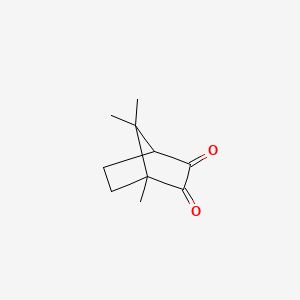| MeSH term | MeSH ID | Detail |
|---|---|---|
| Dental Leakage | D003763 | 5 associated lipids |
| Hemolysis | D006461 | 131 associated lipids |
| Body Weight | D001835 | 333 associated lipids |
Camphorquinone
Camphorquinone is a lipid of Prenol Lipids (PR) class. The involved functions are known as Polymerization. The related lipids are camphoroquinone.
Cross Reference
Introduction
To understand associated biological information of Camphorquinone, we collected biological information of abnormalities, associated pathways, cellular/molecular locations, biological functions, related genes/proteins, lipids and common seen animal/experimental models with organized paragraphs from literatures.
What diseases are associated with Camphorquinone?
There are no associated biomedical information in the current reference collection.
Possible diseases from mapped MeSH terms on references
We collected disease MeSH terms mapped to the references associated with Camphorquinone
PubChem Associated disorders and diseases
What pathways are associated with Camphorquinone
There are no associated biomedical information in the current reference collection.
PubChem Biomolecular Interactions and Pathways
Link to PubChem Biomolecular Interactions and PathwaysWhat cellular locations are associated with Camphorquinone?
There are no associated biomedical information in the current reference collection.
What functions are associated with Camphorquinone?
Related references are published most in these journals:
| Function | Cross reference | Weighted score | Related literatures |
|---|
What lipids are associated with Camphorquinone?
Related references are published most in these journals:
| Lipid concept | Cross reference | Weighted score | Related literatures |
|---|
What genes are associated with Camphorquinone?
There are no associated biomedical information in the current reference collection.
What common seen animal models are associated with Camphorquinone?
There are no associated biomedical information in the current reference collection.
NCBI Entrez Crosslinks
All references with Camphorquinone
Download all related citations| Authors | Title | Published | Journal | PubMed Link |
|---|---|---|---|---|
| Hass U et al. | Combined exposure to anti-androgens exacerbates disruption of sexual differentiation in the rat. | 2007 | Environ. Health Perspect. | pmid:18174960 |
| Lima AF et al. | Influence of light source and extended time of curing on microhardness and degree of conversion of different regions of a nanofilled composite resin. | 2012 | Eur J Dent | pmid:22509117 |
| Aguilar FG et al. | Color and opacity of composites protected with surface sealants and submitted to artificial accelerated aging. | 2012 | Eur J Dent | pmid:22229004 |
| Papadopoulos T et al. | Colour stability of veneering composites after accelerated aging. | 2010 | Eur J Dent | pmid:20396443 |
| Hafez R et al. | Effect of in-office bleaching on color and surface roughness of composite restoratives. | 2010 | Eur J Dent | pmid:20396441 |
| Cruvinel DR et al. | Composites associated with pulp-protection material: color-stability analysis after accelerated artificial aging. | 2010 | Eur J Dent | pmid:20046473 |
| de Oliveira MT et al. | Influence of Diamond Sono-Abrasion, Air-Abrasion and Er:YAG Laser Irradiation on Bonding of Different Adhesive Systems to Dentin. | 2007 | Eur J Dent | pmid:19212560 |
| Khalil SK et al. | Use of FT-Raman Spectroscopy to Determine the Degree of Polymerization of Dental Composite Resin Cured with a New Light Source. | 2007 | Eur J Dent | pmid:19212480 |
| Celik C et al. | Clinical evaluation of resin-based composites in posterior restorations: 12-month results. | 2010 | Eur J Dent | pmid:20046481 |
| Martins GC et al. | Interfacial integrity of bonded restorations with self-etching adhesives: Water storage and thermo-mechanical cycling. | 2012 | Eur J Dent | pmid:22509120 |
